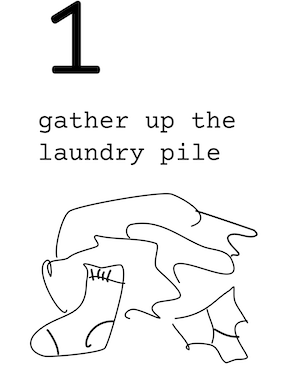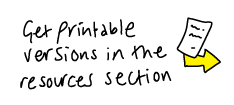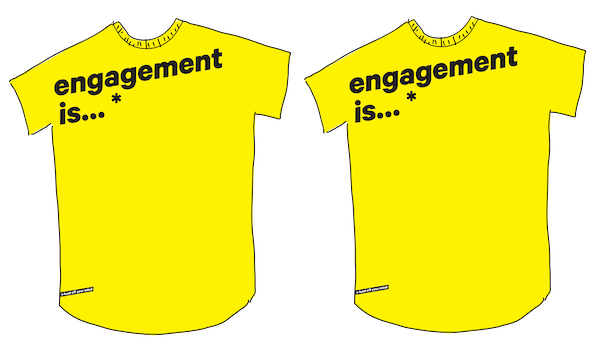Stage 1: gather up the laundry pile
This stage has three parts: Setting the cycle survey; Name tag: finding out about you and Drawing it out: you and your engagement.
The purpose is for the facilitators to find out a bit about the projects that are going to be ‘rinsed out’; to help participants position themselves and think reflexively about their research and their engagement practice; and, in a group setting, do a bit of an icebreaker.
Jump to:
What is ‘Setting the cycle survey’?
At its most basic, it is a questionnaire, either a digital one, or in the zine workbook.
Why?
A pre-laundromat survey is an opportunity to gather useful information to help with planning a laundromat, to tailor activities to a group and to get people into the mindset in advance.
It also gives you a couple of metrics to refer back to when considering if the laundromat made a discernable difference to how people feel about scicomm/engagement after the fact (but, the intent is primarily about planning and personal reflection rather than impact evaluation).
The survey asks about things like the research field of the participants, their expectations of the laundromat (however you are running it – online or in person), their engagement idea, their experience, confidence and motivation in relation to their engagement project, etcetera. That helps you plan if resources can be customised.
If you are trying this out as an individual some questions are less relevant, but it is still a good checklist to get you thinking before you go deeper into the cycle.
These are the standard questions we use:
- What’s your research field? (free text)
- Are there specific things you hope to get out of the laundromat? (free text)
- Please briefly detail the project that you would like to develop an engagement plan/activities for ('project' can be as specific or loose as you like) (free text)
- Is the project you have in mind associated with:(Delete as appropriate or add your own thoughts)
- something else (please expand) (free text)
- broader science literacy (tick box)
- your discipline more generally (tick box)
- your specialist area of research (tick box)
- Is your potential engagement project related to a current or proposed externally-funded research project? (Delete as appropriate or add your own thoughts)
- Not sure (tick box)
- No, definitely not (tick box)
- No, but it could be (tick box)
- Yes, somewhat (tick box)
- Yes, entirely (tick box)
- If relevant, please tell us about the research project your engagement your project relates to (or could relate to) and who funds it (free text)
- What engagement activities do you have in mind for this project (if any)? Have you undertaken any activities so far? (free text)
- Thinking about engagement, what’s your:
- Level of understanding of what engagement is or what it means (0–10 scale, low to high)
- Level of experience (0–10 scale, low to high)
- Level of confidence (0–10 scale, low to high)
- Level of motivation (0–10 scale, low to high)

The zero to ten scales are framed as a ‘washing line’, with only low and high given as descriptors. Participants are invited to ‘clip a peg on the line’; the idea is that this is deliberately playful and low-pressure to encourage self-reflection rather than give us rigorous metrics for future evaluation.
- Anything you’d like to add to the last question? (free text)
- Who are the target audiences for your engagement activities? (free text)
- What are the key messages for your engagement (if you know them at this stage)? (free text)
- Are there any expectations or commitments (for instance to funders) with regard to engagement in this project? (free text)
- Anything else you’d like to add, or questions you’d like answered? (free text)
WHAT IS ‘NAME TAG’?
‘Name tag’ is a way of getting to know people. It's a folded sheet of paper, on the front of which you write what you'd put on your name tag at a meeting – how you'd like to be addressed.
Beyond that, it invites participants to think about how they describe and position themselves, ‘tagging’ from one thing to another. Like a pepeha, it can help position a participant in their relationships and connections to people and place, and to their interests and values.
Beyond the things you normally share when you meet someone, it welcomes you to think about other aspects of yourself that are personally important in one way or another, but you might not normally stick on a ‘name tag’. Perhaps they are things that drive you, or things you have learnt about yourself along the way, or things that have an impact on your life, such as health, or elements of your social situation.
Why?
The intent of ‘name tag’ is to start a group off in a reflexive frame of mind. What does that mean? Canfield & Menezes (2020) call reflexivity ‘Continuous, critical, and systematic reflection on personal identities’ with a view to helping us ‘redress inequitable interactions’. Cunliffe (2016) describes it as ‘questioning what we, and others, might be taking for granted—what is being said and not said—and examining the impact this has or might have’. Salmon et al. (2017) draw attention to a quality of ‘self-questioning, in particular a willingness and ability to question one’s own assumptions, how they relate to societal power structures, and how they shape one’s actions’.
It can be useful to think about this as taking a look at yourself in a ‘mirror’ (what are the top-level things you can see or are quickly shared like where you live and work and what your profession is). Then, taking a look at yourself taking a look at yourself looking in a mirror. What are the less visible or obvious considerations that have shaped you, personally or societally?

An image from the zine showing a completed name tag sheet
The zine and worksheet give the following prompts:
Side 1: face value
What are the more overt parts of how you define yourself? If you’re stuck, try asking:
- What do you like to be called?
- Where is ‘home’?
- Who is your family?
- What do you do for work, and play?
What other things would you tell people the first time you met?
Side 2: hidden depth
These parts can be less visible. You might not want to share them with people (at least not straight away), but you know they’re important to your identity:
- What’s your socioeconomic background?
- What inspires you?
- What worries you?
- Where do you sit politically?
- Are class, race, gender, sexuality, disability or health conditions important to your identity?
Acknowledgment
‘Name tag’ is an exercise that is built on a tool called ‘One Face Many Facets’, developed by Toi Āria – Design for Public Good who have generously allowed us to tailor the concept.
What is ‘Drawing it out’?
‘Drawing it out’ is a way to think about, and talk about, what you look like when you're doing your engagement through drawing a quick sketch. We ask participants to think about this through the following questions/prompts:
- What do you look like as a (science) communicator*?
- What are you wearing? Do you have props? Are you comfortable?
- Where and what is your engagement space?
- Where will this engagement take place? Where are you relative to your audience/participants?
- What does your audience look like?
- How many are there? Were they invited? Where are they and what are they doing? What are they dressed like?
- How do these things relate to each other?
- Draw the relative positions and interactions
- What are you communicating about?
- Give yourself a speech bubble or other way of showing what the content is…

Examples of the ‘drawing it out’ exercise pegged to a washing line
Engagement is…
In addition, we ask at this stage what the participants think engagement or science communication is — how they choose to define it. The asterisk next to the prompt says *there’s no right or wrong answer! We used the term engagement here, but you can have a conversation about using the words that they use for what they’re doing.
Why?
Both these parts become discussion points for a group and lead into the ‘Scicomm 101’ in stage 2, where we cover what the literature might say about this. Look out for audiences that are ‘the general public’, and later, you can talk about different ‘publics’, or the fact that as ‘name tag’ shows, people are nuanced individuals, not a generic, homogenous lump!
The act of drawing, though uncomfortable for some, can be levelling and bring people back to basics. This stage also affords you the chance to build the collective environment by pegging items out on a washing line to share.

Example ‘engagement is…’ prompts pegged up


